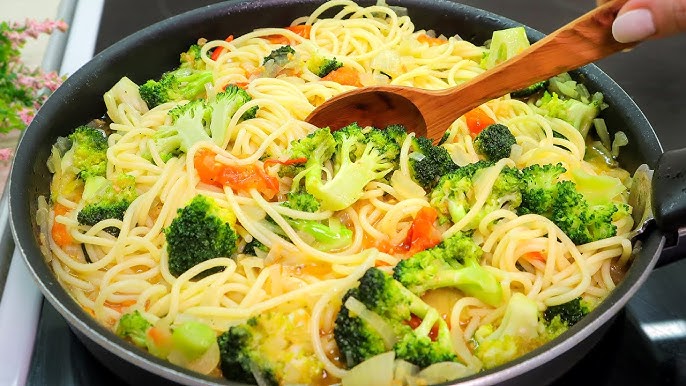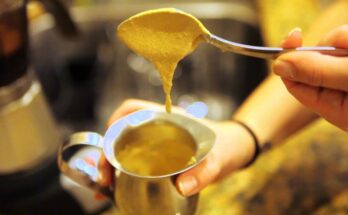Broccoli Pasta Recipe: If you’re looking for a wholesome, flavorful, and easy-to-make meal, broccoli pasta is the perfect choice. It combines the goodness of fresh vegetables with the comfort of pasta, making it ideal for both busy weeknights and weekend dinners. What makes this dish special is its versatility—you can make it creamy, spicy, or light depending on your taste preferences.
In this step-by-step guide, you’ll learn how to make delicious broccoli pasta at home with simple ingredients and minimal effort.
Why Broccoli Pasta is a Perfect Choice
Broccoli pasta is not just another pasta dish—it’s a powerhouse of flavor and nutrition. Unlike heavy pasta dishes loaded with cream and cheese, broccoli pasta balances health and taste. The slightly earthy flavor of broccoli blends beautifully with garlic, olive oil, and parmesan, creating a dish that feels both light and satisfying. Plus, it’s a family-friendly recipe. Even kids who are picky eaters often enjoy broccoli when paired with their favorite pasta shapes.
Another reason broccoli pasta is a great choice is its adaptability. Whether you want a quick weeknight meal or an impressive dinner for guests, this dish fits the bill. You can prepare it in less than 30 minutes, making it a go-to recipe when you’re short on time. Pair it with salad or bread, and you have a complete, well-rounded meal.
Health Benefits of Broccoli Pasta
Broccoli is often referred to as a “superfood,” and for good reason. It’s rich in vitamins C and K, fiber, and antioxidants that support overall health. When combined with pasta, it becomes a balanced dish offering carbs for energy, fiber for digestion, and essential nutrients for immunity.
Broccoli also contains sulforaphane, a compound known to support detoxification and reduce inflammation. Eating broccoli pasta regularly can contribute to heart health, better digestion, and even weight management when prepared with the right balance of ingredients. For vegetarians and those seeking healthier meals, broccoli pasta is a perfect choice that doesn’t compromise on flavor.
Ingredients You’ll Need
Fresh Ingredients for Flavor
The magic of this recipe lies in using fresh, high-quality ingredients. Here’s a list of what you’ll need:
- Fresh broccoli florets (about 3 cups)
- Garlic cloves (4–5, finely minced)
- Fresh basil or parsley (optional, for garnish)
- Lemon zest (for a refreshing flavor twist)
Pantry Staples You Must Have
In addition to fresh produce, some common pantry staples are essential for making broccoli pasta flavorful and delicious:
- Pasta (spaghetti, penne, or fusilli work best)
- Olive oil (extra virgin preferred)
- Salt and black pepper (to taste)
- Red pepper flakes (optional, for a spicy kick)
- Parmesan cheese (grated, for topping)
Substitutes and Variations
Don’t worry if you don’t have all the ingredients—there are plenty of substitutes you can use:
- Use whole wheat or gluten-free pasta for a healthier option.
- Replace olive oil with butter for a richer flavor.
- Swap parmesan with pecorino romano or nutritional yeast (vegan option).
- Add other veggies like zucchini, peas, or spinach for more variety.
The beauty of broccoli pasta lies in its flexibility—you can adjust the recipe to suit your taste and dietary needs.
Kitchen Tools Required
Essential Cooking Tools
To prepare broccoli pasta efficiently, you’ll need some basic kitchen tools:
- A large pot (for boiling pasta)
- A colander (for draining pasta and broccoli)
- A skillet or sauté pan (for cooking garlic and sauce)
- A sharp knife and cutting board (for chopping broccoli and herbs)
- Measuring cups and spoons (for accuracy)
Optional Tools for Better Results
While the essentials are enough, having these optional tools can make the cooking process smoother:
- Microplane or zester (for grating parmesan or lemon zest)
- Tongs (to easily toss pasta with sauce)
- Blender or food processor (if you prefer a creamy broccoli sauce)
Preparing Broccoli for Pasta
How to Clean and Cut Broccoli
Start by rinsing the broccoli thoroughly under cold water to remove any dirt or impurities. Cut the broccoli into bite-sized florets for even cooking. If you don’t want to waste the stems, peel them and slice them thin—they’re just as delicious and nutritious as the florets.
Blanching vs. Roasting Broccoli
There are two popular methods to prepare broccoli for pasta:
- Blanching: Quickly boil broccoli florets for 2–3 minutes, then transfer them to ice water. This method keeps the broccoli bright green and slightly crisp.
- Roasting: Toss broccoli with olive oil, salt, and pepper, then roast at 400°F (200°C) for 15 minutes. Roasting adds a slightly smoky, caramelized flavor.
Both methods work well, and the choice depends on whether you want a fresher or deeper flavor profile.
Step-by-Step Guide to Making Broccoli Pasta
Cooking the Pasta Perfectly
Bring a large pot of salted water to a boil, then add your pasta of choice. Cook until al dente according to package instructions. Reserve about 1 cup of pasta water before draining—it helps bind the sauce later.
Preparing the Sauce
In a skillet, heat olive oil over medium heat. Add minced garlic and sauté until golden and fragrant. Add blanched or roasted broccoli and toss to coat. For extra depth, you can mash some of the broccoli with a fork to create a natural sauce base.
Combining Pasta and Broccoli
Add the drained pasta directly into the skillet with the broccoli. Pour in a bit of reserved pasta water to create a silky sauce. Toss everything together until well combined.
Adding Cheese and Garnish
Finish by sprinkling freshly grated parmesan, lemon zest, and fresh herbs. For a spicy kick, add a pinch of red pepper flakes. Serve hot and enjoy!
Flavor Variations for Broccoli Pasta
Adding Protein (Chicken, Shrimp, Tofu)
One of the best things about broccoli pasta is how easily it adapts to different proteins. If you want to turn it into a more filling meal, simply add your favorite source of protein. For meat lovers, grilled or pan-seared chicken breast pairs beautifully with the earthy taste of broccoli. Cut the chicken into thin strips or cubes and season with garlic, salt, and black pepper before cooking. Shrimp is another excellent option—it cooks in just a few minutes and adds a slightly sweet, seafood flavor that complements the pasta perfectly.
Vegetarians and vegans can go for tofu or tempeh. Pan-fried tofu cubes, seasoned with soy sauce or Italian herbs, bring a delightful texture and protein boost. Tempeh, with its nutty flavor, is also a fantastic addition. Simply cube it, sauté in olive oil, and toss it into the pasta. Adding protein not only enhances the flavor but also makes the dish a complete, balanced meal suitable for lunch or dinner.
Creamy vs. Olive Oil Based Sauce
The beauty of broccoli pasta is that you can choose whether to keep it light or make it indulgent. For a lighter version, stick with olive oil, garlic, and a splash of reserved pasta water. This method highlights the freshness of the broccoli while keeping the dish healthy.
If you’re craving comfort food, a creamy version might be more appealing. You can create a velvety sauce by adding heavy cream, milk, or even a plant-based cream alternative. For extra richness, melt in some cream cheese or ricotta. Another great method is blending part of the cooked broccoli with parmesan and olive oil to create a naturally creamy sauce without adding dairy. This way, you get a thick, flavorful sauce that coats every strand of pasta.
Spicy Broccoli Pasta Variation
If you like bold flavors, a spicy broccoli pasta will not disappoint. Start by adding more red pepper flakes or fresh chili to the garlic and olive oil base. For an extra layer of heat, you can stir in a spoonful of chili paste or use spicy Italian sausage as an add-in.
To balance the spiciness, squeeze a little lemon juice over the dish before serving. The acidity cuts through the heat and makes the flavors pop. If you’re a fan of bold and fiery meals, this spicy version will quickly become one of your favorites.
Serving Suggestions
Side Dishes to Pair with Broccoli Pasta
Broccoli pasta is satisfying on its own, but pairing it with the right side dish can turn it into a complete dining experience. A fresh green salad with a light vinaigrette balances the richness of the pasta. Garlic bread or a crusty baguette is another classic pairing—it helps soak up the delicious sauce.
If you want to serve it as part of a larger meal, consider roasted vegetables like carrots, bell peppers, or asparagus. They add color and variety to your plate while keeping the meal light and nutritious. For gatherings, you can even serve broccoli pasta alongside grilled chicken or baked fish for a more elaborate spread.
Perfect Drinks to Complement the Meal
The right beverage can enhance your pasta-eating experience. For non-alcoholic options, sparkling water with lemon, iced tea, or a refreshing cucumber lemonade pair beautifully with broccoli pasta. If you prefer wine, go for something light and crisp like Sauvignon Blanc or Pinot Grigio—they balance the richness of the pasta without overwhelming the flavors.
For a cozy dinner, a glass of red wine such as Chianti or Merlot can add depth to the meal, especially if you’ve made a creamy version of the pasta. Pairing drinks thoughtfully ensures the meal feels complete and satisfying.
Storage and Reheating Tips
Refrigerating Broccoli Pasta
If you have leftovers, store them properly to keep the flavors intact. Place the cooled pasta in an airtight container and refrigerate for up to 3 days. To prevent the pasta from drying out, drizzle a little olive oil before sealing the container.
Freezing Instructions
Broccoli pasta can also be frozen, but with a few precautions. Place the pasta in freezer-safe containers or bags, making sure to remove as much air as possible. Label with the date and freeze for up to 2 months. Keep in mind that cream-based sauces may separate slightly after thawing, so olive oil-based versions freeze better.
Best Way to Reheat Without Losing Flavor
When reheating, avoid the microwave if possible, as it can make the pasta mushy. Instead, reheat in a skillet with a splash of water or olive oil over medium heat. Toss until warmed through. If you froze your pasta, thaw it overnight in the fridge before reheating. Adding a little extra parmesan or fresh herbs while reheating can revive the flavors and make the pasta taste freshly made.
Nutritional Value of Broccoli Pasta
Calories and Macronutrients
A standard serving of broccoli pasta (about 1½ cups) provides around 350–450 calories, depending on the type of pasta and sauce used. The macronutrient breakdown generally looks like this:
- Carbohydrates: 55–60g (from pasta)
- Protein: 12–18g (higher if you add chicken, shrimp, or tofu)
- Fat: 10–15g (mostly from olive oil and cheese)
This balance makes it a filling yet light meal, perfect for those watching their calorie intake without sacrificing taste.
Vitamins and Minerals from Broccoli
Broccoli itself is a nutrient powerhouse. It provides:
- Vitamin C (boosts immunity and skin health)
- Vitamin K (supports bone health and blood clotting)
- Folate (important for cell repair and energy production)
- Fiber (aids digestion and helps you feel full longer)
Combining pasta with broccoli makes this dish not only tasty but also packed with essential nutrients that support overall health.
Common Mistakes to Avoid When Making Broccoli Pasta
Overcooking the Pasta
The biggest mistake many home cooks make is overcooking the pasta. Remember, pasta continues cooking slightly even after draining. Always cook it al dente (firm to the bite) to ensure the best texture.
Undercooking the Broccoli
On the other hand, undercooked broccoli can ruin the dish by making it too tough or bitter. Blanch or roast the broccoli just enough to keep it tender yet slightly crisp.
Using Too Much or Too Little Sauce
Finding the right balance of sauce is key. Too much sauce can make the pasta heavy and soggy, while too little leaves it dry and flavorless. Start with a small amount of reserved pasta water and add gradually until you achieve a silky, well-coated texture.
FAQs about Broccoli Pasta Recipe
1. Can I make broccoli pasta vegan?
Yes! Making broccoli pasta vegan is very simple. Replace parmesan cheese with nutritional yeast or a vegan cheese alternative. Use olive oil instead of butter, and if you want a creamy sauce, blend cooked broccoli with cashew cream or coconut milk. The flavors remain rich and satisfying, while keeping the dish completely plant-based.
2. What pasta shape works best with broccoli pasta?
While you can use any pasta, short varieties like penne, fusilli, or rigatoni work especially well because they hold the broccoli and sauce in their grooves. If you prefer long pasta, spaghetti or linguine are excellent choices too. The key is to pick a shape that allows the sauce and broccoli pieces to cling well for maximum flavor.
3. How do I keep broccoli pasta from drying out?
The trick is to save some pasta water before draining the pasta. Adding this starchy water to the skillet while tossing the pasta and broccoli helps create a silky, cohesive sauce that prevents dryness. If you’re reheating leftovers, a small drizzle of olive oil or splash of water also helps restore moisture.
4. Can I prepare broccoli pasta ahead of time?
Yes, you can partially prepare it ahead of time. Cook the pasta until just under al dente and blanch the broccoli. Store them separately in airtight containers in the fridge. When ready to serve, quickly sauté garlic in olive oil, add the broccoli and pasta, and finish with seasonings and cheese. This method ensures your pasta doesn’t get soggy.
5. How do I make broccoli pasta more filling?
If you want to turn broccoli pasta into a hearty meal, add protein like grilled chicken, shrimp, or tofu. You can also mix in beans such as chickpeas or white beans for extra fiber and plant-based protein. Topping it with extra cheese, nuts like toasted pine nuts, or seeds such as pumpkin seeds can also boost satiety.
Conclusion
Broccoli pasta is the ultimate blend of comfort and nutrition. It’s quick to make, incredibly versatile, and customizable to fit every taste preference. From light olive oil-based versions to creamy indulgent sauces, this dish proves that healthy meals don’t have to be boring. The combination of perfectly cooked pasta, fresh broccoli, and simple seasonings creates a dish that’s both satisfying and wholesome.
Whether you’re cooking for yourself, your family, or guests, broccoli pasta is a recipe that never disappoints. It’s budget-friendly, easy to prepare, and perfect for busy weeknights or elegant dinners. With the right techniques and ingredients, you’ll have a go-to pasta dish that brings both comfort and nutrition to your table.
So next time you’re craving pasta, give this broccoli pasta recipe a try—it’s simple, delicious, and sure to become a staple in your kitchen.



